Billionaires are a threat to democracy.
Most rich people got rich by taking advantage of other people.
Wealth should be taken from the rich and given to the poor.
Those are a few statements on which most people can agree — most people under age 30, that is, according to the Cato 2019 Welfare, Work, and Wealth National Survey.
A few days ago, the Academy Award for Best Picture went to a foreign language film for the first time in Oscar history. The Guardian calls Parasite, a Korean comedy-thriller, “a searing satire of a family at war with the rich,” and the subtitled film saw unexpected popularity in U.S. theaters. Simultaneously, a presidential candidate who stakes his campaign on a fight with billionaire oligarchs has just taken the lead in national poll averages for the Democratic primary race.
This country has always had a precarious relationship with its super-wealthy. The richest rich have, at various points in history, filled Americans with fascination or anger. Lately, a trend toward the latter is evident, and it follows a long tradition of distrust of the upper crust.
Sometimes, the historical parallels of American attitudes toward wealth reveal themselves in subtle ways.
Last March, then-presidential candidate and entrepreneur John Hickenlooper appeared on MSNBC’s Morning Joe to talk about his presidential bid. Host Joe Scarborough commended Hickenlooper’s business success as “an advertisement for American capitalism” and asked the candidate if he was a proud capitalist. When Hickenlooper evaded the question, decrying the label, Scarborough asked twice more — visibly losing patience each time — if the small business man would even consider himself a capitalist.
Larry Glickman, a professor of history at Cornell University, says he has used this clip in one of his classes to illustrate the criticism of so-called robber barons of the late nineteenth century: “In the Gilded Age, ‘capitalist’ was really a term given by its enemies to people who had earned wealth in an unfair, immoral way, so a lot of small business men said something similar to what Hickenlooper said.” Glickman says the distrust of robber barons (or capitalists) comes back to the question of hard work. “There was this idea that you had labor producing things, and that accumulating wealth through honest production was a good thing,” he says, “but there was a new class of people called capitalists getting their wealth through unproductive, exploitative ways.”
British economist John Stuart Mill referred to this kind of wealth — in the mid-19th century — as the “unearned increment.” Divine right was un-American, but passive income was filling the wallets of a select few in the country while farmers and workers struggled. Men like Cornelius Vanderbilt, J.P. Morgan, and John D. Rockefeller acquired hundreds of millions of dollars in the 19th century by building monopolistic empires and strong-arming competition (and their own workers) into submission.
It was against this backdrop of economic disparity that heiress Cornelia Bradley Martin decided to stage an exclusive gathering for the country’s financial elite.
In 1897, the New York socialite hatched an idea for a costume ball in the Waldorf Hotel that she hoped would be the most extravagant party in the nation’s history. With thousands of orchids and roses, rare tapestries and velvet canopies, and terrine de foie gras, Cornelia would dress as Mary, Queen of Scots, while her husband played a member of Louis XV’s court. Hundreds more of the rich elite would turn up dressed mostly in historic royal garb, like the dozen Marie Antoinettes who, perhaps, had forgotten about the queen’s fate.
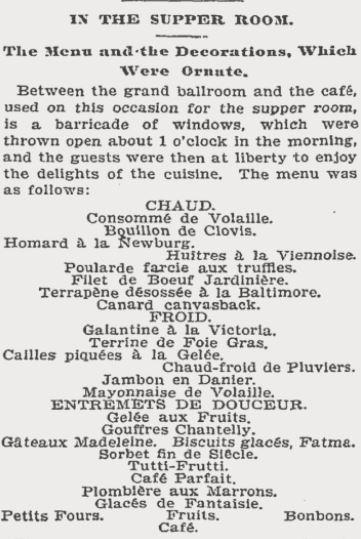
At St. George’s Episcopal Church in New York, where the congregation included the likes of J.P. Morgan, the clergyman warned his flock against attending Mrs. Bradley Martin’s ball: “Never were the lines between the two classes — those who have wealth and those who envy them — more distinctly drawn … Such elaborate and costly manifestations of wealth would only tend to stir up widespread discontent.” When the night came, hundreds of policemen — led by Theodore Roosevelt — closed the sidewalks outside the Waldorf to pedestrians to make way for the giant dress-up party.
Newspapers around the country, and even many society people, criticized the ostentatiousness (or plain stupidity) of the ball. The Brotherhood of Locomotive Engineers’ Monthly Journal wrote, “The Bradley Martins are said to have spent $300,000 … which would have made glad thousands upon thousands of the poor of New York who are struggling in abject poverty, was used up in some five or six hours of the grossest exhibition of the arrogance of wealth America has ever witnessed.” The host and hostess were puzzled by all of the bad press, since they believed their event had stimulated New York’s economy. After all, “many New York shops sold out brocades and silks which had been lying in their stock-rooms for years.”
Meanwhile, New York’s tenements were filled with people living in crowded, unsanitary apartments, as evidenced by Jacob Riis’s How the Other Half Lives in 1890. Poor and immigrant children worked long hours at factories, and families slept together in rooms stacked with beds.
As the various lower classes grappled with the complications of Victorianism receding, a vocabulary for condemning the lavishness of the rich was taking shape. In 1899, Thorstein Veblen wrote The Theory of the Leisure Class, a groundbreaking volume of social and economic criticism that explained the extravagances that had emerged, as well as the phenomenon of “conspicuous consumption,” in industrial societies. “The possession of wealth confers honour; it is an invidious distinction,” Veblen wrote.
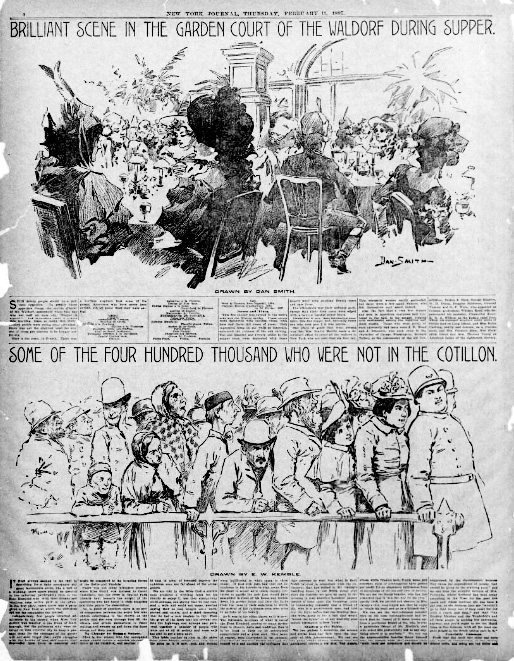
That same year, the pages of this magazine recorded the details of the still-excessive lives of New York society, particularly the new set that had grown accustomed to fancy evenings out every night of the year: “Take the dinner with its costly delicacies, wines and flowers, at so much per head; add to that a seat in a portière box at the opera afterward; and go on to the ball or cotillion where the money lavished upon decorations, music, supper at little tables, toilettes and jewels represents an aggregation of opulence almost incredible to the outsider.”
It wasn’t always like this, though, according to the author, Mrs. Burton Harrison, a genteel woman who had lived through the Civil War: “Quiet people who recall the New York of earlier days, and shared in its social diversions then as now, may well stand back in astonishment at our swift advance in luxury.” Mrs. Harrison felt the great wealth accumulation of society families, like the Bradley Martins and the Vanderbilts, was acceptable, even if it had “in theory, no right to exist in an overgrown democracy,” but she believed Americans would adore their burgeoning aristocracy: “our people are fain to give it more deference than the English, or any of the Continental European peoples, bestow on even their reigning family.”
But Mrs. Harrison’s ruby-colored spectacles must have prevented her from seeing the writing on the wall. With the coming Progressive Era, populist politics were on the rise and disdain for the “upper ten” was taking hold across the country.
Historian Michael McGerr wrote in A Fierce Discontent: The Rise and Fall of the Progressive Movement in America:
By choice and by necessity, America’s social classes lived starkly divergent daily lives and invoked different and often conflicting values to guide, explain, and justify their ways of life. The classes held distinctive views on fundamental issues of human existence: on the nature of the individual: on the relationship between the individual and society.
The Progressive Era brought reform that curbed some excess wealth and confronted corruption around the country, but, as McGerr makes clear, the individualist philosophy behind the Carnegies’ and the Rockefellers’ rise to wealth and power persevered.
Likewise, glimpses into the daily lives of the one percent still provoked amusement and ire.
In 1920, Wall Street reporter Edwin Lefèvre derided “some wretchedly rich people” in a Post article called “The Annoyances of Being Rich Today.” Without naming names, Lefèvre detailed conversations with bankers and heirs about their gripes with imperfect service and ungrateful butlers. One rich man told the author that he feared a revolution was afoot after he asked a waiter for bread and — instead of silent obedience — the response came: “Sure thing!” Others complained about accusations of vanity or the prospect of their service staff seeking higher wages.
Lefèvre sums up the groans of the plutocrats by casting wealth as a sort of illness:
I am convinced that there is a definite social disease which we may call gold poisoning. When a man has too much gold, some of it gets into the system; through the pores, it almost seems. It causes deafness and affects the sight. These ailments, gold deafness and gold blindness, are responsible for most of the annoyances of which the stricken rich so bitterly complain today. Instead of seeing or hearing, they are merely aware of a rumbling sound—the tread of their fellow men marching toward them, armed with bombs, bitterness, and taxes.
F. Scott Fitzgerald, even after having seen financial success, wrote about the illnesses of wealth. In his 1926 novel The Rich Boy, Fitzgerald describes the spiritual corruption of the rich, how “they are different from you and me,” and how “they think, deep in their hearts, that they are better than we are because we had to discover the compensations and refuges of life for ourselves.”
Historian Larry Glickman says there is a tradition of suspicion of great wealth because “there is a feeling that at least some of that wealth did not emerge from honest labor but by illegitimate means.” He says this suspicion remains in the background of American life until it is pushed into prominence in a forceful way every couple of generations or so, sometimes because conditions become unbearable for people who are not rich.
Glickman says the Occupy movement and the subsequent Bernie Sanders campaigns have been a somewhat delayed reaction to decades of rising wealth inequality. What follows, historically, is something like a “rich man’s panic” or “elite victimization,” Glickman says, over calls for a more level playing field, like progressive taxation. In 2014, businessman Tom Perkins warned of a “Progressive Kristallnacht” over what he called The San Francisco Chronicle’s demonization of the rich. Although he apologized for the Nazi reference, other billionaires have publically renounced so-called class demonization.
But as long as extreme wealth continues to accumulate among America’s elite, the young and indebted may always see the complaints of the one percent as mere groans from the costumed aristocracy of a nonstop masked ball.
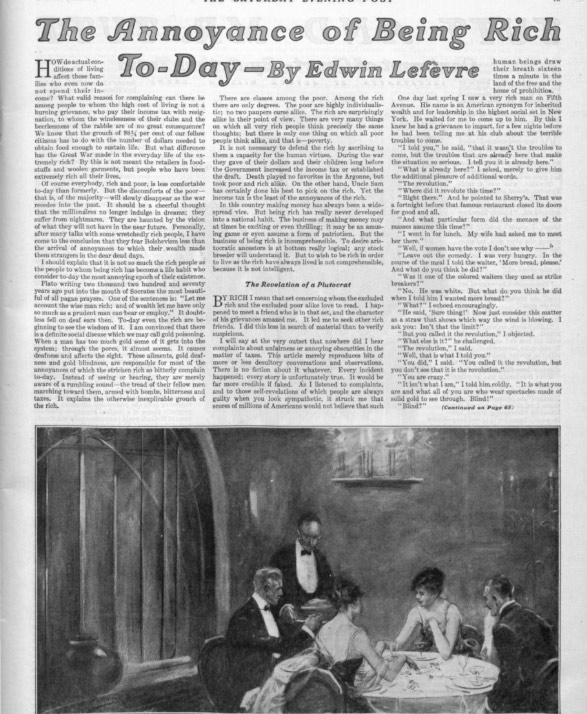
Featured image: Illustration from “How to Live on $36,000 a Year” by F. Scott Fitzgerald from the April 5, 1924, issue of The Saturday Evening Post, ©SEPS
Become a Saturday Evening Post member and enjoy unlimited access. Subscribe now
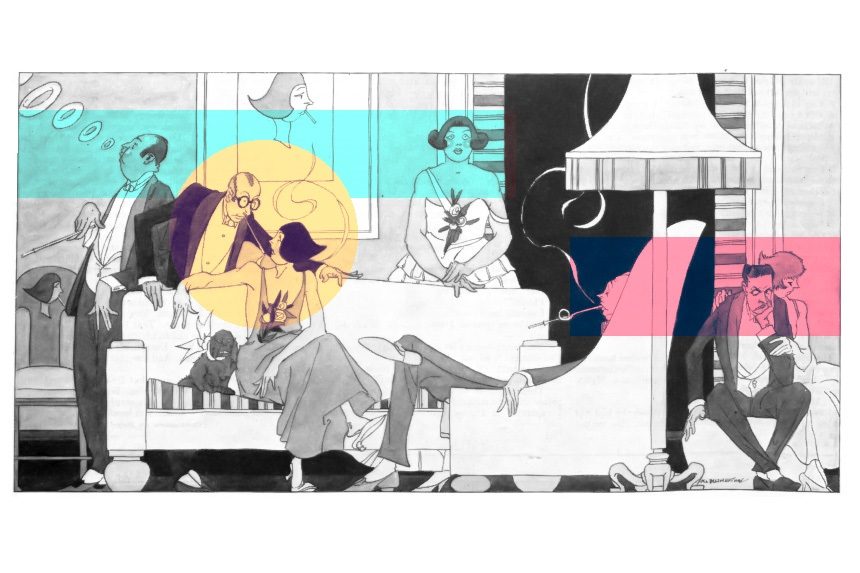
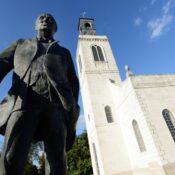
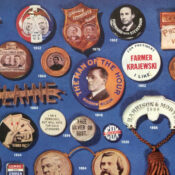

Comments
Forgot to include that the mid sixties, I believe, was when the ability to earn faster than the cost of living was rising went hand in hand. Someone had to pay for all of these increasing benefits.
Sociologists and their ilk convinced congress and the electorate that if we’d just increase welfare benefits to a level that allowed the recipients a standard of living above bare subsistence that we’d be building a framework just like a building that would, after a couple of generations be filled in. At this time given the recipients an amount that would let them live better, respectful lives they would eventually get use to the better conditions and work to provide it themselves.
As usual the government forgot about greed and President Lincoln’s warning. I mean really, why work when you can laze about, sell some drugs, live w/your girl friend rent free and join organizations demanding your civil war reparations.
Great article Nick, with a lot of research that went into it. I agree with Working Man’s comments preceding mine. The whole feature does read like a description of today, and in all honesty, most of the last 50 years.
The extremes described here unfortunately, are more the norm than things being fair for the average American to live the good life. Even the wealthiest in the Gilded Age didn’t have the disgusting “outer space” incomes we see today. Not too many years ago, multi-millionaire was considered the ultimate, Now it’s multi-multi billionaire. I’m waiting for that to become multi-trillionaire!
The wonderful post-war economy America enjoyed between 1945-1970 was (in large part) because so much of the rest of the world was in ruin and we were unchallenged. All that began changing not long after the climactic decade of the century (the ’60s) ended. Nixon took the U.S. off the gold standard in 1971, the awful Vietnam War (which fueled the economy) effectively ended at the end of 1972 with Nixon’s bombings of it. In 1973 came the first oil crisis and the beginnings of terrible inflation combined with stagnant wages for most Americans that have remained that way ever since. (See the July/August 2019 POST feature on ‘forced-budget’ family vacations in the 1970’s).
Excessive CEO wages (over the average employee) began to noticeably rise around ’74 and really took off in the ’80s-present where they’re absolutely unfathomable. Not all CEO’s, but enough to make the economy very lopsided. Though we were considered to have ‘good economies’ overall between Reagan to Trump, things have just gotten worse for the average American, or lucky to be stuck in neutral; not falling behind, but not getting ahead either.
Los Angeles, Ca., decades past its desirable prime when housing costs and apartment rental fees were low and it wasn’t dirty and crowded, are now among the most expensive of anywhere, nationwide. $2,200 per month rental for a tiny ‘studio’ apartment in the ‘poor’ sections of it. Yes, you read that right. And Disneyland just raised their admissions fee up to $154 to $209, depending on the day.
Greed is NOT good, but for most of human history the average person has had to deal with the pain and suffering of it, because it was/is the norm. If most of us had pay increases comparable to Disneyland’s single-ticket prices from 1973 ($3.50) to the present over the the years however, it sure would be a nice dream; but that’s about it.
“Divine right was un-American, but passive income was filling the wallets of a select few in the country while farmers and workers struggled.”
Reads like a description of today. This sort of parasitism seems so normal.
Perhaps our government is so full of liars because they’ve long lost touch with anyone doing honest work.
People need to internalize the Tenth Commandment: “Thou shalt not envy thy neighbor’s goods.”
Good to know that these leeches are hated pretty much across the Globe. Gives a certain hope of getting rid of them eventually.